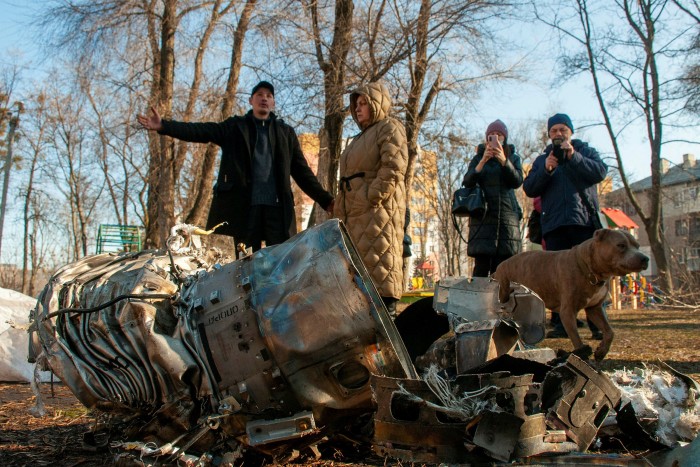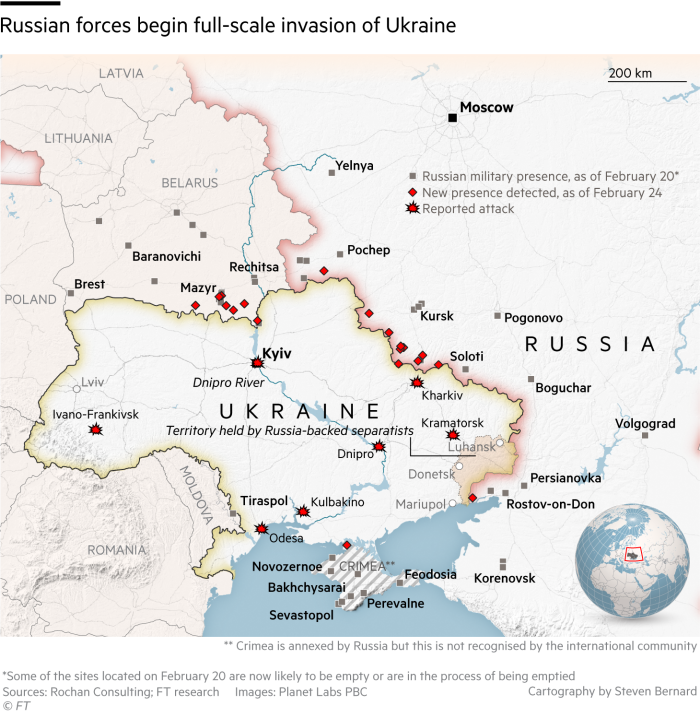
[ad_1]
Missile strikes against air defences and critical military infrastructure, a rocket bombardment against major troop locations followed by a three-pronged land attack: Russia’s invasion of Ukraine began just as western military intelligence had predicted.
Within hours of President Vladimir Putin’s vow to “de-Nazify” Ukraine with a full invasion of the country, Russian tanks and troops were rolling across the border. The first lines of Ukraine’s defences were severely pounded by a precision missile barrage in an assault that western officials fear could devastate eastern Ukraine and besiege Kyiv in a matter of days.
“The Russian have such supremacy that it’s effectively a bulldozer that can, given time, go anywhere. The capability is such that they can take territory almost as quick as they like,” said a senior western intelligence official. “The key variable factor is how much the Ukrainians can put up a fight and give Putin a bloody nose.”
Starting at 5am on Thursday, long-range, precision missile strikes fired by ground launchers and from ships in the Black Sea hit Ukraine’s air defence systems, command and control infrastructure, air bases and large troop concentrations. Russian Kh-31P missiles, designed to target enemy radar and communication infrastructure, were used extensively.
That paved the way for a land assault along three axes, with two likely initial aims: a move south using troops from the 30,000-strong deployment in Belarus that analysts said could encircle Kyiv, running simultaneously with a larger pincer movement using troops moving north from Crimea and west from Russia to cut off the bulk of Ukraine’s army deployed in the east of the country from the capital.

Within six hours of Putin’s war declaration, Russian forces were on the outskirts of Kharkiv, Ukraine’s second-largest city and a critical location for Russian troops moving west to Kyiv.
Western capitals believe Putin “wants to suffocate rather than flatten Kyiv”, the senior intelligence official said, but there are widespread concerns over how high the death toll could be, given the Russian president’s stated aim to “demilitarise” a country with a standing army of 215,000 troops.
“So far, the Kremlin has focused on taking out civil infrastructure key to maintaining Ukrainian fighting functions. It may now expand to taking out human infrastructure in order to weaken Ukrainian resistance,” said Samuel Cranny-Evans, a military analyst at the Royal United Services Institute in London.
That brutal assessment refers to western intelligence briefings which have warned that Russia has a kill list of Ukrainians to be attacked or detained on invasion.
“The key thing is what is Russia’s end goal? The actions will fit that,” said Cranny-Evans. “If they only go where Ukrainian forces are, that speaks to Putin’s repeated statements of ‘demilitarising Ukraine’. Regime change would follow. If Russian troops go into the cities, where there are likely no Ukrainian forces, that suggests a different goal.”
The critical question that could determine the fate of the war is whether Ukraine’s forces can organise a strategic retreat to avoid encirclement or find a fallback line from which they can successfully resist or delay the Russian advance westward, said Michael Kofman, senior research scientist at CNA, a US-based think-tank.
“Quantitatively and qualitatively, Russia has considerable supremacy here. Ukrainians are facing a grim situation,” Kofman said. “We should not be surprised by early Russian ground advances, as the question is when will Ukrainian forces choose to hold the line.”

A secondary objective will be to secure Ukraine’s coastline with an assault on Odesa, analysts say, leveraging Russia’s large naval deployments. Russia shut down access to the Sea of Azov, the part of the Black Sea between Crimea and eastern Ukraine, and western officials said it was likely to be impossible for Turkey to agree to a plea from Kyiv to close off the Bosphorus to possible Russian naval reinforcements or resupplies.
There has so far been no evidence that the Russian assault has been accompanied by a wave of crippling cyber attacks targeting Ukraine’s power supply and communications networks, as western capitals had earlier anticipated.
Intelligence shared among Nato allies suggests that in the medium-term Putin could require about 600,000 troops in Ukraine to tackle both a strong initial defence from the Ukrainian armed forces and suppress a guerrilla war from resistance fighters after the state is captured.
“I suspect this will be a stop-go operation: two to four days of advance, pause and recoup to assess the situation — militarily, politically,” said Mathieu Boulègue, research fellow at Chatham House’s Eurasia programme. “Next steps depend on acceptable casualty rates for the military — but that is an internal Russian decision.”
“It looks like a maximalist approach, but could be a deception strategy to merely take the Donbas,” he continued, referring to the eastern region of Ukraine occupied by Russia-backed separatists.
“[The] important question is: what is the end game, the war termination strategy, what will the map of Ukraine look like at the end of it all?”
[ad_2]
Source link